 W
WIslamic art encompasses the visual arts produced in the Islamic world. Islamic art is difficult to characterize because it covers a wide range of lands, periods, and genres, including Islamic architecture, Islamic calligraphy, Islamic miniature, Islamic glass, Islamic pottery, and textile arts such as carpets and embroidery.
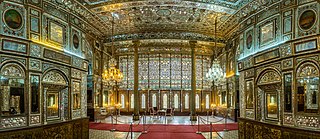 W
WĀina-kāri is a kind of interior decoration made by Iranian artists who assemble finely cut mirrors together in geometric, calligraphic or foliage forms. This creates a beautiful shining surface covered with complex facets, reflecting light as intricate abstract patterns or glittering reflections. Beside their decorative use, this art is used as a strong durable cover for an interior space of a building.
 W
WAngels have appeared in works of art since early Christian art, and they have been a popular subject for Byzantine and European paintings and sculpture.
 W
WAniconism is the avoidance of images of sentient beings in some forms of Islamic art. Islamic aniconism stems in part from the prohibition of idolatry and in part from the belief that creation of living forms is God's prerogative. Although the Quran does not explicitly prohibit visual representation of any living being, it uses the word musawwir as an epithet of God. The corpus of hadith contains more explicit prohibitions of images of living beings, challenging painters to "breathe life" into their images and threatening them with punishment on the Day of Judgment. Muslims have interpreted these prohibitions in different ways in different times and places. Religious Islamic art has been typically characterized by the absence of figures and extensive use of calligraphic, geometric and abstract floral patterns.
 W
WThe arabesque is a form of artistic decoration consisting of "surface decorations based on rhythmic linear patterns of scrolling and interlacing foliage, tendrils" or plain lines, often combined with other elements. Another definition is "Foliate ornament, used in the Islamic world, typically using leaves, derived from stylised half-palmettes, which were combined with spiralling stems". It usually consists of a single design which can be 'tiled' or seamlessly repeated as many times as desired. Within the very wide range of Eurasian decorative art that includes motifs matching this basic definition, the term "arabesque" is used consistently as a technical term by art historians to describe only elements of the decoration found in two phases: Islamic art from about the 9th century onwards, and European decorative art from the Renaissance onwards. Interlace and scroll decoration are terms used for most other types of similar patterns.
 W
WFirouz Bagherzadeh was an Iranian archaeologist, Islamic art scholar, and expert on ceramics and Islamic inscriptions.
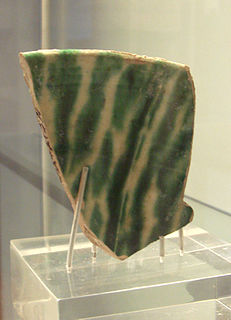 W
WChinese influences on Islamic pottery cover a period starting from at least the 8th century CE to the 19th century. This influence of Chinese ceramics has to be viewed in the broader context of the considerable importance of Chinese culture on Islamic arts in general.
 W
WEdmund Robert Anthony de Unger was a Hungarian-born property developer and art collector. In London he built up the Keir Collection, one of the greatest post-war collections of Islamic art, bequeathed in 2008 to the Pergamon Museum of Islamic Art in Berlin. The arrangement for the museum to curate the collection came to an end in July 2012. The collection is now hosted by the Dallas Museum of Art as of May 2014 for a 15-year renewable loan.
 W
WDoris Duke was an American billionaire tobacco heiress, philanthropist, art collector, horticulturalist, and socialite. She was often called "the richest girl in the world". Her great wealth, luxurious lifestyle, and love life attracted significant press coverage, both during her life and after her death.
 W
WAnatolian animal carpets represent a special type of pile-woven carpet, woven in the geographical region of Anatolia during the Seljuq and early Ottoman period, corresponding to the 14th–16th century. Very few animal-style carpets still exist today, and most of them are in a fragmentary state. Animal carpets were frequently depicted by Western European painters of the 14th–16th century. By comparison of the few surviving carpets with their painted counterparts, these paintings helped to establish a timeline of their production, and support our knowledge about the early Turkish carpet.
 W
WEngare is a puzzle game created by Iranian game designer Mahdi Bahrami and soundtracked by Mim Rasouli, playable on PC and MacOS. Describing itself as "a game about motion and geometry", Engare's design is based upon Islamic art and sacred geometry. The game consists of two gameplay modes: a puzzle-solving mode, where the player has to recreate shapes shown onscreen by placing a point on a moving object, akin to a Spirograph tool, and a free-form art tool allowing the player to design their own patterns. First prototyped in 2010, Engare was released in October 2017, and retails for $6.99 on Steam and Bahrami's website. The game's release was delayed by difficulties caused by international sanctions imposed upon Iran, making it difficult for Bahrami to travel and access resources.
 W
WGirih are decorative Islamic geometric patterns used in architecture and handicraft objects, consisting of angled lines that form an interlaced strapwork pattern.
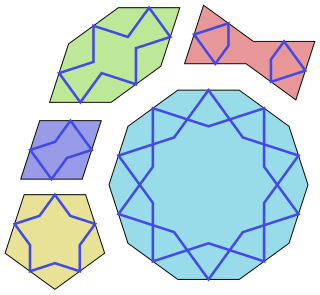 W
WGirih tiles are a set of five tiles that were used in the creation of Islamic geometric patterns using strapwork (girih) for decoration of buildings in Islamic architecture. They have been used since about the year 1200 and their arrangements found significant improvement starting with the Darb-i Imam shrine in Isfahan in Iran built in 1453.
 W
WThe influence of the Islamic world to the history of glass is reflected by its distribution around the world, from Europe to China, and from Russia to East Africa. Islamic glass developed a unique expression that was characterized by the introduction of new techniques and the innovation of old traditions.
 W
WA gul is a medallion-like design element typical of traditional hand-woven carpets from Central and West Asia. In Turkmen weavings they are often repeated to form the pattern in the main field.
 W
WHedwig glasses or Hedwig beakers are a type of glass beaker originating in the Middle East or Norman Sicily and dating from the 10th-12th centuries AD. They are named after the Silesian princess Saint Hedwig (1174–1245), to whom three of them are traditionally said to have belonged. So far, a total of 14 complete glasses are known. The exact origin of the glasses is disputed, with Egypt, Iran and Syria all suggested as possible sources; if they are not of Islamic manufacture they are certainly influenced by Islamic glass. Probably made by Muslim craftsmen, some of the iconography is Christian, suggesting they may have been made for export or for Christian clients. The theory that they instead originate from Norman Sicily in the 11th century was first fully set out in a book in 2005 by Rosemarie Lierke, and has attracted some support from specialists.
 W
WIn the visual arts, interlace is a decorative element found in medieval art. In interlace, bands or portions of other motifs are looped, braided, and knotted in complex geometric patterns, often to fill a space. Interlacing is common in the Migration period art of Northern Europe, especially in the Insular art of Ireland and the British Isles and Norse art of the Early Middle Ages and in Islamic art.
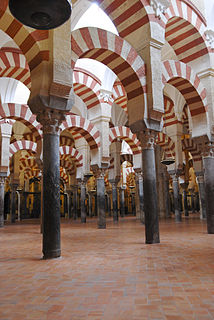 W
WIslamic architecture comprises the architectural styles of buildings associated with Islam. It encompasses both secular and religious styles from the early history of Islam to the present day. Islamic architecture developed to fulfill Islamic religious ideals, for example, the Minar was designed to assist the Muezzin in making his voice heard to throughout a specific area.
 W
WIslamic calligraphy is the artistic practice of handwriting and calligraphy, in the languages which use Arabic alphabet or the alphabets derived from it. It includes Arabic, Persian, Ottoman, and Indian calligraphy. It is known in Arabic as khatt Arabi, which translates into Arabic line, design, or construction.
 W
WEmbroidery was an important art in the Islamic world from the beginning of Islam until the Industrial Revolution disrupted traditional ways of life.
 W
WAn Islamic garden is generally an expressive estate of land that includes themes of water and shade. Their most identifiable architectural design reflects the Charbagh quadrilateral layout with four smaller gardens divided by walkways or flowing water. Unlike English gardens, which are often designed for walking, Islamic gardens are intended for rest, reflection, and contemplation. A major focus of the Islamic gardens was to provide a sensory experience, which was accomplished through the use of water and aromatic plants.
 W
WIslamic geometric patterns are one of the major forms of Islamic ornament, which tends to avoid using figurative images, as it is forbidden to create a representation of an important islamic figure according to many holy scriptures.
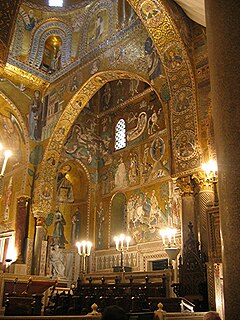 W
WIslamic influences on Western art refers to the influence of Islamic art, the artistic production in the Islamic world from the 8th to the 19th century, on Christian art. During this period, the frontier between Christendom and the Islamic world varied a lot resulting in some cases in exchanges of populations and of corresponding art practices and techniques. Furthermore, the two civilizations had regular relationships through diplomacy and trade that facilitated cultural exchanges. Islamic art covers a wide variety of media including calligraphy, illustrated manuscripts, textiles, ceramics, metalwork and glass, and refers to the art of Muslim countries in the Near East, Islamic Spain, and Northern Africa, though by no means always Muslim artists or craftsmen. Glass production, for example, remained a Jewish speciality throughout the period, and Christian art, as in Coptic Egypt continued, especially during the earlier centuries, keeping some contacts with Europe.
 W
WIslamic ornament is the use of decorative patterns in Islamic art. They can be broadly divided into the arabesque, using curving plant-based elements, geometric patterns with straight lines or regular curves, and calligraphy, consisting of religious texts with stylised appearance, used both decoratively and to convey meaning. All three often involve elaborate interlacing. The three types of ornament are often used together.
 W
WThe Khalili Collection of the Hajj and the Arts of Pilgrimage is a private collection of around 4,500 items relating to the Hajj, the pilgrimage to the holy city of Mecca which is a religious duty in Islam. It is one of eight collections assembled, conserved, published and exhibited by the British-Iranian scholar, collector and philanthropist Nasser Khalili; each collection is considered among the most important in its field. The collection's 300 textiles include embroidered curtains from the Kaaba, the Station of Abraham, the Mosque of the Prophet Muhammad and other holy sites, as well as textiles that would have formed part of pilgrimage caravans from Egypt or Syria. It also has illuminated manuscripts depicting the practice and folklore of the Hajj as well as photographs, art pieces, and commemorative objects relating to the Hajj and the holy sites of Mecca and Medina.
 W
WThe Khalili Collections are eight distinct art collections assembled by Nasser D. Khalili over five decades. Together, the collections include some 35,000 works of art, and each is considered among the most important in its field.
 W
WKurar ) is a type of Arabic embroidery of weaving gold, silver and silk threads to create ribbons used to decorate clothing.
 W
WThe "Luck of Edenhall" is an enamelled glass beaker that was made in Syria or Egypt in the middle of the 14th century, elegantly decorated with arabesques in blue, green, red and white enamel with gilding. It is now in the Victoria and Albert Museum in London and is 15.8 cm high and 11.1 cm wide at the brim. It had reached Europe by the 15th century, when it was provided with a decorated stiff case in boiled leather with a lid, which includes the Christian IHS; this no doubt helped it to survive over the centuries.
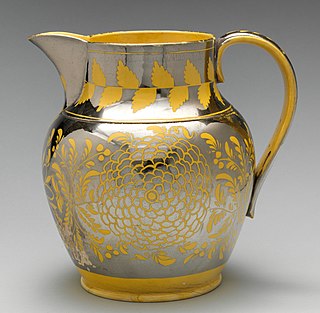 W
WLustreware or Lusterware is a type of pottery or porcelain with a metallic glaze that gives the effect of iridescence. It is produced by metallic oxides in an overglaze finish, which is given a second firing at a lower temperature in a "muffle kiln", or a reduction kiln, excluding oxygen.
 W
WMany studies have been conducted on Mamluk carpets, but scholars have not come to a consensus as to when or where they were made. Production of surviving Mamluk carpets started from the second half of the fifteenth century until the middle of the sixteenth century, and continued even after the Ottoman conquest of Egypt in 1517. The group of carpets produced in this period were initially called "Damascene" carpets after their attribution to Damascus, Syria. However, a Cairene origin was established after some fragments of carpets in this style were unearthed in Fustat. Furthermore, there are several eyewitness accounts by travelers placing a center of carpet production in Cairo.
 W
WMinaret Khaje Alam belongs to the Timurid Empire and is located at Hatef street in Isfahan. This relic was recorded in Iran’s National Hertage on 6 January 1932.
 W
WMosque lamps of enamelled glass, often with gilding, survive in considerable numbers from the Islamic art of the Middle Ages, especially the 13th and 14th centuries, with Cairo in Egypt and Aleppo and Damascus in Syria the most important centres of production. They are oil lamps, usually with a large round bulbous body rising to a narrower waist, above which the top section is flared. There is usually a foot so they can be placed on a surface, but they were normally used suspended by chains that went through a number of loops on the outside of the body. They were used to light mosques and other buildings in mosque complexes, in large spaces in groups hanging from a circular metal frame. The circular frames continue to be used in many mosques today, but with plain or frosted glass lamps for electric lighting.
 W
WHassan Sobhi Mourad was an academic, a calligrapher, an artist, a researcher, an author and a poet. He specialized in Arabic Calligraphy, its development and teaching, drawing to all age groups, as well as contributing in writing art-related articles. Born in Syria, Hassan Mourad lived abroad in various countries and continents for over thirty-five years due to his career in diplomatic service. Though living abroad for most of his adult life, he remained passionate about the Arabic Language, its history and the art of Arabic Calligraphy. Mourad was influenced at the early age of 14 by a fellow Syrian writer without having ever met him; this artist, AbdulRahman Fakhoory, predicted a bright future in art for Mourad.
 W
WThe Mshatta Facade is the decorated part of the facade of the 8th-century Umayyad residential palace of Qasr Mshatta, one of the Desert Castles of Jordan, which is now installed in the south wing of the Pergamon Museum in Berlin, Germany. It is part of the permanent exhibition of the Pergamon Museum of Islamic Art dedicated to Islamic art from the 8th to the 19th centuries. This was only a relatively small section of the full length of the facade, surrounding the main entrance; most of the wall was undecorated and remains in situ.
 W
WCarpets of Middle-Eastern origin, either from Anatolia, Persia, Armenia, Azerbaijan, the Levant, the Mamluk state of Egypt or Northern Africa, were used as decorative features in Western European paintings from the 14th century onwards. More depictions of Oriental carpets in Renaissance painting survive than actual carpets contemporary with these paintings. Few Middle-Eastern carpets produced before the 17th century remain, though the number of these known has increased in recent decades. Therefore, comparative art-historical research has from its onset in the late 19th century relied on carpets represented in datable European paintings.
 W
WThe Painting of the Six Kings is a fresco found on the wall of Qasr Amra, a desert castle of the Umayyad Caliphate located in modern-day Jordan. It depicts six rulers standing in two rows of three. Four of the six have inscriptions in Arabic and Greek identifying them as the Byzantine emperor, King Roderic of Hispania, the Sasanian emperor, and the Negus of Aksum. The painting, now substantially damaged, is thought to be from between 710 and 750, commissioned by the Umayyad caliph or someone in his family. It is one of the most famous frescoes in the Qasr Amra complex.
 W
WPancar Merah is an Islamic talisman found among the Banjar people from South Borneo. It is used to protect and defend the bearer when dealing with people of high status such are tribal leaders or kings.
 W
WA Persian carpet or Persian rug, also known as Iranian carpet, is a heavy textile made for a wide variety of utilitarian and symbolic purposes and produced in Iran, for home use, local sale, and export. Carpet weaving is an essential part of Persian culture and Iranian art. Within the group of Oriental rugs produced by the countries of the "rug belt", the Persian carpet stands out by the variety and elaborateness of its manifold designs.
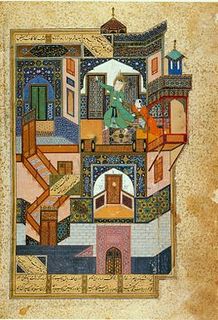 W
WA Persian miniature is a small Persian painting on paper, whether a book illustration or a separate work of art intended to be kept in an album of such works called a muraqqa. The techniques are broadly comparable to the Western Medieval and Byzantine traditions of miniatures in illuminated manuscripts. Although there is an equally well-established Persian tradition of wall-painting, the survival rate and state of preservation of miniatures is better, and miniatures are much the best-known form of Persian painting in the West, and many of the most important examples are in Western, or Turkish, museums. Miniature painting became a significant genre in Persian art in the 13th century, receiving Chinese influence after the Mongol conquests, and the highest point in the tradition was reached in the 15th and 16th centuries. The tradition continued, under some Western influence, after this, and has many modern exponents. The Persian miniature was the dominant influence on other Islamic miniature traditions, principally the Ottoman miniature in Turkey, and the Mughal miniature in the Indian sub-continent.
 W
WPietra dura or pietre dure [ˈpjɛːtre ˈduːre], called parchin kari or parchinkari in the Indian Subcontinent, is a term for the inlay technique of using cut and fitted, highly polished colored stones to create images. It is considered a decorative art. The stonework, after the work is assembled loosely, is glued stone-by-stone to a substrate after having previously been "sliced and cut in different shape sections; and then assembled together so precisely that the contact between each section was practically invisible". Stability was achieved by grooving the undersides of the stones so that they interlocked, rather like a jigsaw puzzle, with everything held tautly in place by an encircling 'frame'. Many different colored stones, particularly marbles, were used, along with semiprecious, and even precious stones. It first appeared in Rome in the 16th century, reaching its full maturity in Florence. Pietra dura items are generally crafted on green, white or black marble base stones. Typically, the resulting panel is completely flat, but some examples where the image is in low relief were made, taking the work more into the area of hardstone carving.
 W
WThe Pisa Griffin is a large bronze sculpture of a griffin, a mythical beast, that has remained in Pisa, Italy since the Middle Ages despite its Islamic origin, specifically 11th century Al-Andalus. The Pisa Griffin is the largest medieval Islamic metal sculpture known, standing over three feet tall. It has been described as the "most famous as well as the most beautiful and monumental example" of a tradition of zoomorphic bronzes in Islamic art. The griffin is now in the Museo dell'Opera del Duomo, Pisa. The griffin seems at first a historical anomaly given its elusive origin and multiplicity of possible uses, including a fountainhead or musical instrument. However, its possible origin can be approximated by comparing it to similar sculptures of its time, namely the animalistic sculptures and fountains of Al-Andalusian palatial settlements. Furthermore, the griffin may share a similar method of construction, and therefore origin, as the Al-Andalusian fountainheads based on the metallic contents of its bronze alloy.
 W
WMedieval Islamic pottery occupied a geographical position between Chinese ceramics, the unchallenged leaders of Eurasian production, and the pottery of the Byzantine Empire and Europe. For most of the period it can fairly be said to have been between the two in terms of aesthetic achievement and influence as well, borrowing from China and exporting to and influencing Byzantium and Europe. The use of drinking and eating vessels in gold and silver, the ideal in ancient Rome and Persia as well as medieval Christian societies, is prohibited by the Hadiths, with the result that pottery and glass were used for tableware by Muslim elites, as pottery also was in China but was much rarer in Europe and Byzantium. In the same way, Islamic restrictions greatly discouraged figurative wall-painting, encouraging the architectural use of schemes of decorative and often geometrically-patterned titles, which are the most distinctive and original specialty of Islamic ceramics.
 W
WPseudo-Kufic, or Kufesque, also sometimes Pseudo-Arabic, is a style of decoration used during the Middle Ages and the Renaissance, consisting of imitations of the Arabic Kufic script, or sometimes Arabic cursive script, made in a non-Arabic context: "Imitations of Arabic in European art are often described as pseudo-Kufic, borrowing the term for an Arabic script that emphasizes straight and angular strokes, and is most commonly used in Islamic architectural decoration". Pseudo-Kufic appears especially often in Renaissance art in depictions of people from the Holy Land, particularly the Virgin Mary. It is an example of Islamic influences on Western art.
 W
WQashani or Kashani is a Persian decorative arts which had been popular in Iran in the 16th to 18th century, and then moved to Turkey in the time of the Ottomans with the transfer of many Persians artists to Turkey, becoming the basis for decorating the walls of mosques, palaces, shrines and tombs. It is a square-shaped ceramic tile which uses Persian-like floral-depicting 4- or 6-sided glazed tiles, decorated with blue, cyan, green and sometimes red colors. The decoration is surrounded by fine black lines that make it stand out on its white floor. The tile work had often been decorated by the inscription, floral and geometrical patterns. The inscription often provides Qur'anic verses or sentences related to historical events written in Persian script. The plant often consists of natural flowers such as lily, cloves, roses and cypress trees. Geometrical patterns consists of different geometrical shapes and polygons. In Morocco, similar artistic technique is known as zillij. Its use has been widespread in the decoration of the walls of the buildings in the Ottoman era, and this mosaical feature can also be seen in the Dome of the Rock in Jerusalem. Kashi, the abbreviated form of Qashani, was also introduced to Sindh, Kutch, and Multan where numerous examples of shrines and mosques embellished with blue, white and green tile work exist.
 W
WA robe of honour was a term designating rich garments given by medieval and early modern Islamic rulers to subjects as tokens of honour, often as part of a ceremony of appointment to a public post, or as a token of confirmation or acceptance of vassalage of a subordinate ruler. They were usually produced in government factories and decorated with the inscribed bands known as ṭirāz.
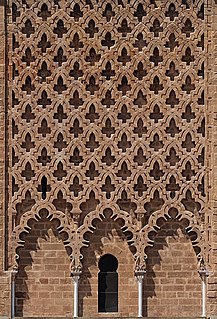 W
WSebka refers to a type of decorative motif used in historic western Islamic ("Moorish") architecture, Mudéjar architecture, and up to present-day Moroccan architecture.
 W
WIn Islamic art, a shamsa is an intricately decorated rosette or medallion which is used in many contexts, including manuscripts, carpets, ornamental metalwork and architectural decoration such as the underside of domes. It can take a number of overall shapes, from circles to stars. The name means "little sun", as a diminutive of shams, the Arabic word meaning "sun", and the work is often stylised as a sunburst. It is characterized by the recurrent motifs present in Islamic art, such as the use of geometrical floral or vegetal forms in a repetitive design known as an arabesque. The arabesque is often used to symbolize the transcendent, indivisible and infinite nature of God, and as with other patterns and forms of Islamic art, the shamsa also has a religious significance, such as symbolizing the unity of God.
 W
WA sitara or sitarah is an ornamental curtain used in the sacred sites of Islam. A sitara forms part of the kiswah: the cloth covering of the Kaaba in Mecca. Another sitara adorns the Prophet's Tomb in the Al-Masjid an-Nabawi mosque in Medina. These textiles bear embroidered inscriptions of verses from the Quran and other significant texts. Sitaras have been created annually since the 16th century as part of a set of textiles sent to Mecca. The tradition is that the textiles are provided by the ruler responsible for the holy sites. In different eras, this has meant the Mamluk Sultans, the Sultans of the Ottoman Empire, and presently the rulers of Saudi Arabia. The construction of the sitaras is both an act of religious devotion and a demonstration of the wealth of the rulers who commission them.
 W
WTiraz are medieval Islamic embroideries, usually in the form of armbands sewn onto robes of honour (khilat). They were bestowed upon high-ranking officials who showed loyalty to the Caliphate, and given as gifts to distinguished individuals. They were usually inscribed with the ruler's names, and were embroidered with threads of precious metal and decorated with complex patterns. Tiraz were a symbol of power; their production and export were strictly regulated, and were overseen by a government-appointed official.
 W
WThe Topkapı Scroll is a Timurid dynasty pattern scroll in the collection of the Topkapı Palace museum.
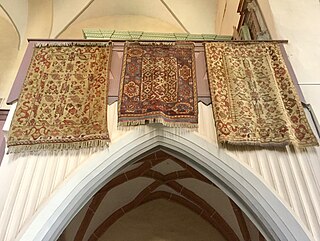 W
WThe name Transylvanian rug is used as a term of convenience to denote a cultural heritage of 15th–17th century Islamic rugs, mainly of Ottoman origin, which have been preserved in Transylvanian Protestant churches. The corpus of Transylvanian rugs constitutes one of the largest collections of Ottoman Anatolian rugs outside the Islamic world.
 W
WZellīj is a style of mosaic tilework made from individually hand-chiseled tile pieces set into a plaster base. The pieces were typically of different colours and fitted together to form elaborate geometric motifs, such as radiating star patterns. This form of Islamic art is one of the main characteristics of Moroccan architecture and medieval Moorish architecture. Zellij became a standard decorative element along lower walls, in fountains and pools, and for the paving of floors. It is found commonly in historic buildings throughout the region, as well as in modern buildings making use of traditional designs such as the Hassan II Mosque in Casablanca which adds a new color palette with traditional designs.